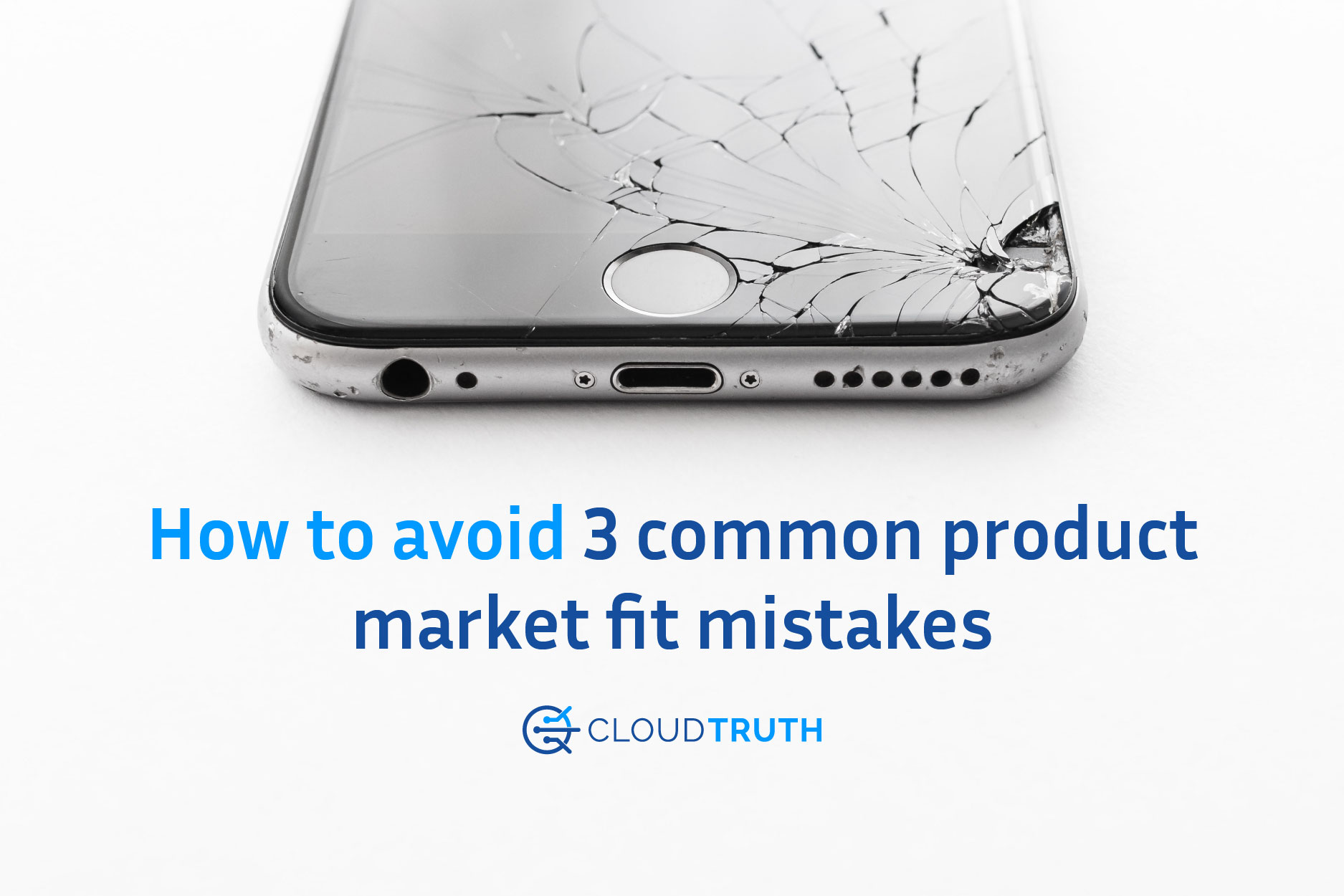- Platform
- Why Us?
-
- Trusted by leading enterprise engineering teams.
- Enterprise-level support from config, IaC & cloud experts.
- Hosted on your platform or ours.
- Sync your config from anywhere.
- Our Mission
- News
-
- Trusted by leading enterprise engineering teams.
- Enterprise-level support from config, IaC & cloud experts.
- Hosted on your platform or ours.
- Sync your config from anywhere.
-
- Pricing
- Resources
- TruthTalk
Product Market Fit Inside CloudTruth Configuration Management
3 Common Product-Market Fit Pitfalls and How to Avoid Them
April 8, 2021


This is the second post – “The CloudTruth Journey to Product-Market Fit” series.
Reaching product-market fit is essential for any business to succeed. But what does it take to actually identify a strong target market and determine the best product to meet customer needs?
In the previous blog post in this series, I described CloudTruth’s approach to finding product-market fit. Over the course of a year, we conducted more than 400 customer interviews, repeatedly iterated on our offerings, and ultimately settled on a product that already has early adopter customers with huge growth potential. I’m so proud of everything we’ve achieved — but of course, our journey hasn’t been without its pitfalls. That’s why in this post, I wanted to share a little more on some of the hurdles we’ve faced, and the strategies that helped us overcome them:
Don’t Fall for False Positives
One of the obstacles in searching for product-market fit is the “false positive.” A false positive refers to any time when you think you’ve identified a promising opportunity, but it’s not actually as good as it seems. For example, when we surveyed potential customers in our target market, respondents would sometimes tell us that a particular pain point was really important — but in reality, it wasn’t a significant enough problem for them to spend any actual time or money addressing it.
False positives can be particularly tricky to identify because as a startup founder, you are naturally biased to assume the problem you’re trying to solve is important, and that customers will want your proposed solution. But given that natural bias, it’s all the more important to be aware of the potential for false positives, and make sure you’re checking that any trends you’ve identified are consistent across your dataset.
One way to approach this is to categorically dismiss a certain percent of the topmost positive and most negative responses. There will always be a handful of people who absolutely love your concept (or who absolutely hate it). Those people are most likely outliers, and so to identify trends more representative of a larger market, it’s often best to leave those extremes out of your analysis.
Another way to reduce the potential for inaccurate responses is to triangulate around your idea, rather than soliciting feedback specifically on your proposed product. Instead of describing exactly what problem you want to solve and how you intend to solve it, ask participants about a general problem space, and let them come to their own conclusions around potential solutions. This reduces the chances that they are simply latching onto the first idea they’ve heard and makes it more likely that you’ll get some real market insight.
Finally, sometimes a certain survey question just doesn’t lend itself to helpful responses. In those cases, you may want to try either rewording your questions or seeing if another survey format might be more conducive to helpful answers. Similarly, if you find that you’re reaching diminishing returns, hearing similar responses over and over again, that could be a sign that you’re onto something — but it could also mean your questions are leading people to give you a falsely positive impression. To counteract that, try switching from an online questionnaire to a phone interview, adopting a different line of questioning, or rethinking the scope of some of the questions you’re asking.
Curious about what the CloudTruth Configuration Intelligence Platform is all about… join the early access program.
Beware the “Soft Yes”
Sometimes a positive indication isn’t false per se — but it’s not as strong as it may seem. For example, a customer may appear generally positive about your product idea, and may even say that they would buy it, only to disappear as soon as you get off the phone, ignoring your follow-up requests or offers to become a beta tester. This is what I call a “soft yes.” It’s when a customer seems fully on board, but in hindsight, it becomes clear that they weren’t as enthusiastic as they had appeared.
As with false positives, the first step to counteract this is to increase your awareness of your own potential bias. Perhaps a survey participant sounded excited on the phone — but how much of that excitement was their genuine feeling about your product, and how much might you have been projecting your emotions onto them? Always take your own immediate reactions with a grain of salt, and consider asking a colleague to weigh in if you’re not sure how to interpret a conversation.
In addition, it’s important to be intentional about searching for the “hard no” or the “hard yes”: that is, a definitive answer you can trust unequivocally. Be on the lookout for certain giveaway phrases: A hard no might sound like, “I don’t see any value in your proposed solution,” or, “The problem you’re describing just isn’t that important to me.” Conversely, a hard yes will sound something like, “I have this problem all the time, and your solution would help me today.”
A soft yes might sound more like, “I’d love to learn more about your product, it sounds really interesting,” or, “Sure, feel free to reach out with more information.” These responses may sound positive, but they’re a far cry from a real hard yes. It takes patience, but if you want to get accurate information, it’s essential that you determine whether the responses you’re hearing are just soft yesses or real affirmations of your product direction.
Set Yourself Up for Success
Finally, it’s easy to forget that interviews aren’t just about the interviewee — they’re also about the person asking the questions. To run a smooth, effective interview, it’s important to take the time to prepare and make sure you’ve set up everything you need. Here are a few specific areas to consider:
- Always record your calls (with the interviewee’s permission), and transcribe them if possible. This will ensure information can easily be shared across your team, and that any insights gleaned can be referenced and reviewed later.
- Come up with a list of questions in advance. Even if you end up going off script, this will help you stay on track and cover everything you want to ask.
- Be aware of how much time you spend talking. You’re conducting these interviews to learn from your interviewees — so consciously limit how much you speak, and give them the opportunity to share their perspective without interruptions or leading questions.
- If you’re conducting interviews via video conference, consider turning off self-view. Research has shown that this can help you reduce your cognitive load and focus more effectively on the person you’re talking to.
- Do your best to eliminate unhelpful filler words, such as “yeah,” “um,” and “so.” This will both make conversations more concise and will make it easier to transcribe the call.
- When setting up interviews, don’t be pushy (you’re asking someone to donate their time, after all) — but don’t be afraid to confirm multiple times to make sure the interview actually happens. If the interviewee is comfortable with it, ask for both their work and personal emails, in order to ensure that the invite ends up on the right calendar. In our interview process, we found that many no-shows were simply due to the fact that the invitation never made it onto the person’s work calendar, and so asking for multiple emails offered an easy fix.
Of course, there’s no one-size-fits-all solution for growth. Every company will discover its own hurdles along the way and must chart its own path towards determining the best product design for its specific customer base. But no matter how unique your business is, there are also many challenges that are common to almost all startups — from false positives to soft yesses to the tactical components of running an effective interview. I hope that by sharing CloudTruth’s experiences and lessons learned, we can help other companies to avoid these pitfalls and work towards achieving their own product-market fit.
Read the next article in our “CloudTruth Product Market Fit” series:
How a Military Framework Helped CloudTruth Find Product-Market Fit
Join ‘The Pipeline’
Our bite-sized newsletter with DevSecOps industry tips and security alerts to increase pipeline velocity and system security.
Continue exploring
Continue Reading

